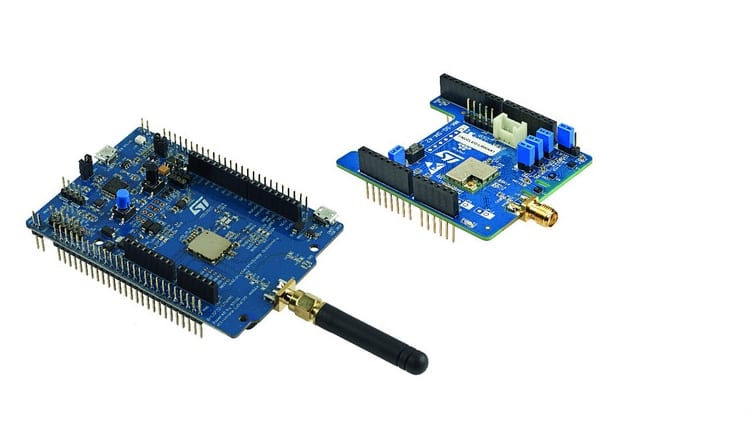The B-L072Z-LRWAN1 and I-NUCLEO-LRWAN1 are the newest LoRa development boards from ST. In the age of connected devices, sub-gigahertz networks are the latest El Dorado, and ST is pioneering this brave new world with great software that speeds up prototyping, and powerful transceivers that can last 10 years on a single battery.
One technology at the forefront of this new age is LoRa™, short for LoRaWAN or Long Range Wide Area Network, an already popular standard connecting smart cities across the world. It relies on a narrowband protocol that greatly reduces noise, while remaining very affordable. Although it does support bi-directional communication, it is primarily aimed at devices that mostly demand one-way exchanges, like smart meters. As this “One-Million-Node IoT Network” continues to gain traction, ST’s new boards will prove invaluable to both corporations and enthusiasts who wish to try, learn, and develop applications that will be part of this revolution.
B-L072Z-LRWAN1 : Fewer Steps Before Mass Production
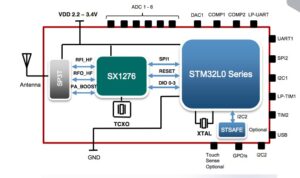
The B-L072Z-LRWAN1 is the result of a long and fruitful partnership with Murata. Indeed, the development board uses the CMWX1ZZABZ-091, which includes an STM32L0 MCU (microcontroller), and the SX1276 LoRa transceiver from Semtech. Hence, this is the ultimate prototyping tool for corporations that can immediately start working on applications, then take the 12.5 mm x 11.6 mm x 1.76 mm module and integrate it in their own design, with small changes to their original code. ST freely provides Gerber files, the bill of material, and the schematics of the B-L072Z, so the move from prototype to final design is as smooth and easy as possible.
The STM32L072CZ found in the CMWX1ZZABZ-091 uses a 32-bit core running at 32 MHz. It integrates three voltage-scaling modes to increase overall efficiency, and the architecture can drop power consumption to as low as 0.29 µA in standby. Furthermore, the chip reduces wake up time from Flash memory to only 5 µs. As LoRa devices spend most of their time in a sleep state, but must be ready to function quickly, because some of the information they transmit can be time-sensitive, this STM32L0 MCU represents the best MCU to run a wide range of applications, while featuring great power-saving features. As a result, devices installed can remain in use for a very long time without the need for maintenance, greatly increasing the return on the investment required to deploy large connected infrastructures.
B-L072Z-LRWAN1 : Facilitating Real-World Applications
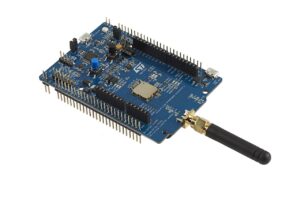
To facilitate experiments in real-world settings, the B-L072Z-LRWAN1 includes a 3xAAA battery holder, so engineers can test their applications in the field without tethering their prototype. The presence of an Arduino Uno V3 connector also means they can add expansion cards to quickly widen their range of possibilities. For instance, one could use ST’s X-NUCLEO-IKS01A2, which contains accelerometers, thermometers, and other sensors, to create new types of applications.
The CMWX1ZZABZ-091 is also a powerful tool because it was designed to be an open module, giving developers access to all the MCU’s timers and interfaces. Hence, unlike a more traditional Arduino board, which tends to more restricted in functionality, the STM32L0’s 11 timers open a whole world of possibilities. For instance, its 16-bit ultra-low-power timer has an independent clock and can run in stop mode. As a result, it can act as a watchdog timer capable of waking the system and rebooting applications in case of a crash or malfunction. Developers can more easily implement defensive strategies to handle failures better, limiting the need for hands-on support.
I-NUCLEO-LRWAN1 And I-CUBE-LRWAN : LoRa Doesn’t Have to Be Hard !
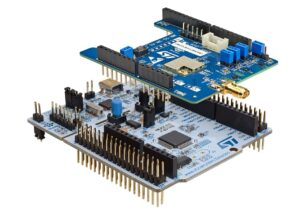
The other product announced today, the I-NUCLEO-LRWAN1, is for those who prefer to work on a Nucleo-32 base. The expansion board uses the same SX1272 transceiver as the B-L072Z-LRWAN1, but the PCB sits on top of a Nucleo development board, which greatly facilitates any experimentation. For instance, one can add the X-NUCLEO-IDW01M1 Wi-Fi card to create a node connected to the Internet. The I-NUCLEO-LRWAN1 also includes an accelerometer, a magnetometer (LSM303AGR), a relative humidity and temperature sensor (HTS221), as well as a pressure sensor (LPS22HB), to enable the creation of applications using contextual information, without having to add an extra board.
ST also eases the learning curve associated with mastering a new sub-gigahertz network by freely providing the I-CUBE-LRWAN software stack. Students and engineers of all levels will have access to the source code of three applications to quickly connect a board to a node (classA) or to another LoRa object (PingPong). The package also contains documentation on the Cortex Microcontroller Software Interface Standard, and all the necessary drivers, like those for the IKS01A2. Therefore, in one of our previous examples, experts using the sensor board with the B-L072Z-LRWAN1 have all the tools they need in one package. On a side note, users of both products will have to upgrade their board’s ST-LINK firmware, and install the Windows ST-LINK USB drivers, before starting any development operations.
The Private Sector at LoRa’s Door
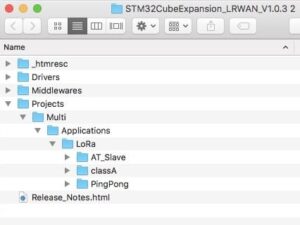
Very often, people talking about LoRa focus on big public projects like a smart grid. However, more and more private applications take advantage of it because it enables applications that weren’t possible before. For instance, before LoRa, a limousine company desiring to track its fleet would have had to connect its GPSs to a cellular network, which is both extremely expensive, and power hungry. However, if a city offers LoRa connectivity, GPSs can send location data using the sub-gigahertz network much more effectively. Hence, as more and more private projects seek to take advantage of this network, ST’s I-NUCLEO-LRWAN1, and B-L072Z-LRWAN1, will enable anyone to start developing real-world applications that could be tomorrow’s big idea.
There are many more things we could say about these two boards to explain how game-changing they are, but we also realize that any attempt at exhaustivity is futile. Thus, since the proof is in the puTTY, we encourage you to grab a board, your favorite terminal emulator, and start experiencing the power of a LoRa network running on an STM32 platform. For $46.50 rrp (B-L072Z-LRWAN1), or a mere $25 rrp (I-NUCLEO-LRWAN1), you not only get a groundbreaking certified solution, but access to powerful development tools, and a thriving community of like-minded engineers looking to do amazing things.
To know more about the next revolutions, please visit the life.augmented blog. For information on all of ST’s products, please visit its website.
